inflation pressure TOYOTA PRIUS PLUG-IN HYBRID 2018 Owners Manual
[x] Cancel search | Manufacturer: TOYOTA, Model Year: 2018, Model line: PRIUS PLUG-IN HYBRID, Model: TOYOTA PRIUS PLUG-IN HYBRID 2018Pages: 772, PDF Size: 107.88 MB
Page 5 of 772

5
1
9
8
7
6
5
4
2
PRIUS PHV_OM_OM47C99E_(EE)
3
7-1. Maintenance and care
Cleaning and protecting
the vehicle exterior ..........572
Cleaning and protecting
the vehicle interior ...........577
7-2. Maintenance
Maintenance
requirements....................583
7-3. Do-it-yourself maintenance
Do-it-yourself service
precautions ......................586
Hood ..................................589
Positioning a floor jack .......591
Engine compartment..........592
Tires ...................................606
Tire inflation pressure ........622
Wheels ...............................624
Replacing the tire ...............627
Air conditioning filter ..........639
Wiper rubber
replacement .....................643
Electronic key battery ........646
Checking and replacing
fuses ................................649
Light bulbs .........................653
8-1. Essential information
Emergency flashers .......... 662
If your vehicle has to
be stopped in an
emergency ...................... 663
8-2. Steps to take in an
emergency
If your vehicle needs
to be towed ..................... 664
If you think something is
wrong .............................. 670
If a warning light turns on
or a warning buzzer
sounds ............................ 671
If a warning message is
displayed ......................... 680
If you have a flat tire .......... 688
If the hybrid system will
not start ........................... 706
If the electronic key does
not operate properly ........ 708
If the 12-volt battery is
discharged ...................... 712
If your vehicle
overheats ........................ 718
If the vehicle becomes
stuck................................ 723
7Maintenance and care8When trouble arises
Page 15 of 772
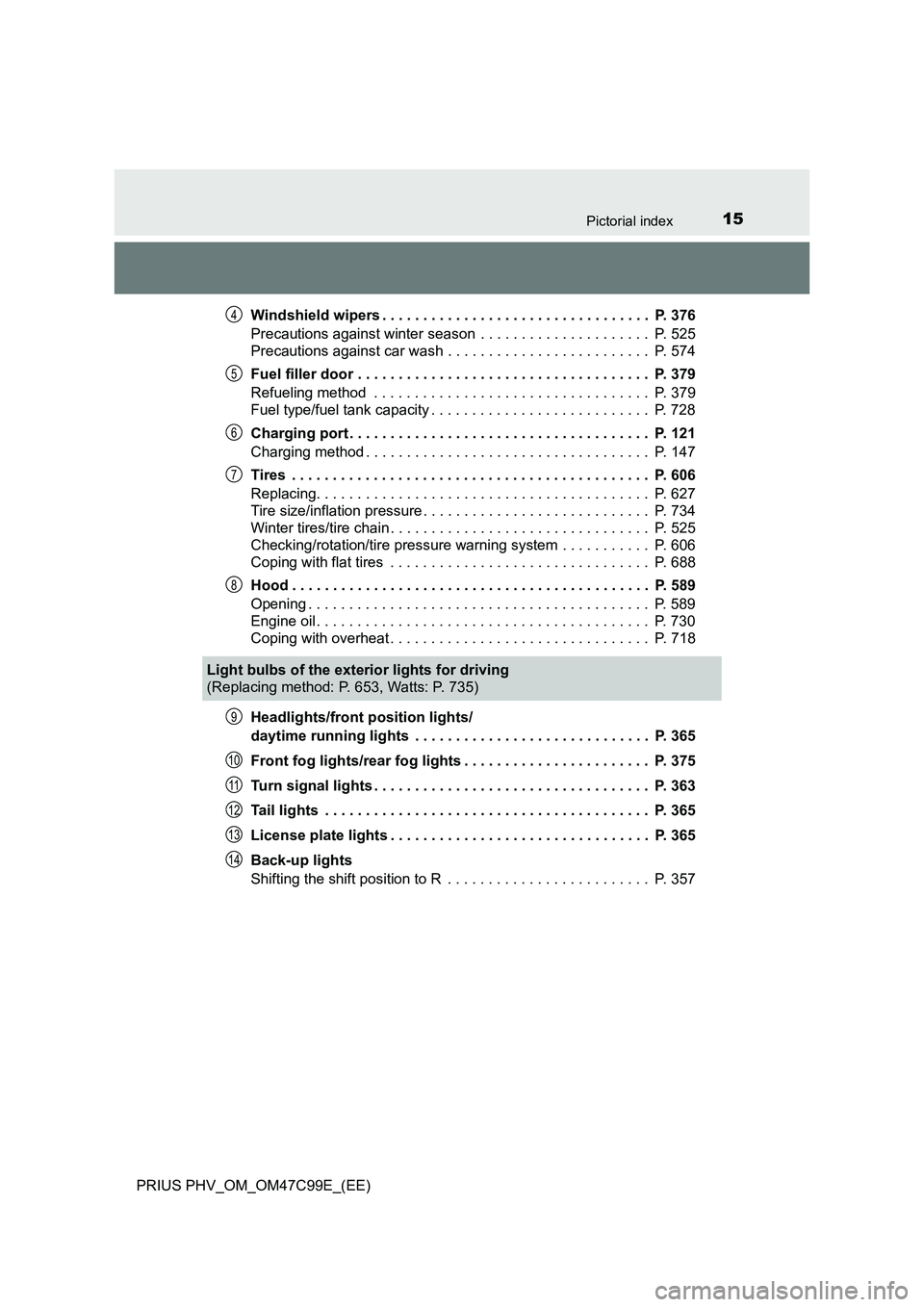
15Pictorial index
PRIUS PHV_OM_OM47C99E_(EE)Windshield wipers . . . . . . . . . . . . . . . . . . . . . . . . . . . . . . . . . P. 376
Precautions against winter season . . . . . . . . . . . . . . . . . . . . . P. 525
Precautions against car wash . . . . . . . . . . . . . . . . . . . . . . . . . P. 574
Fuel filler door . . . . . . . . . . . . . . . . . . . . . . . . . . . . . . . . . . . . P. 379
Refueling method . . . . . . . . . . . . . . . . . . . . . . . . . . . . . . . . . . P. 379
Fuel type/fuel tank capacity . . . . . . . . . . . . . . . . . . . . . . . . . . . P. 728
Charging port . . . . . . . . . . . . . . . . . . . . . . . . . . . . . . . . . . . . . P. 121
Charging method . . . . . . . . . . . . . . . . . . . . . . . . . . . . . . . . . . . P. 147
Tires . . . . . . . . . . . . . . . . . . . . . . . . . . . . . . . . . . . . . . . . . . . . P. 606
Replacing. . . . . . . . . . . . . . . . . . . . . . . . . . . . . . . . . . . . . . . . . P. 627
Tire size/inflation pressure . . . . . . . . . . . . . . . . . . . . . . . . . . . . P. 734
Winter tires/tire chain . . . . . . . . . . . . . . . . . . . . . . . . . . . . . . . . P. 525
Checking/rotation/tire pressure warning system . . . . . . . . . . . P. 606
Coping with flat tires . . . . . . . . . . . . . . . . . . . . . . . . . . . . . . . . P. 688
Hood . . . . . . . . . . . . . . . . . . . . . . . . . . . . . . . . . . . . . . . . . . . . P. 589
Opening . . . . . . . . . . . . . . . . . . . . . . . . . . . . . . . . . . . . . . . . . . P. 589
Engine oil . . . . . . . . . . . . . . . . . . . . . . . . . . . . . . . . . . . . . . . . . P. 730
Coping with overheat . . . . . . . . . . . . . . . . . . . . . . . . . . . . . . . . P. 718
Headlights/front position lights/
daytime running lights . . . . . . . . . . . . . . . . . . . . . . . . . . . . . P. 365
Front fog lights/rear fog lights . . . . . . . . . . . . . . . . . . . . . . . P. 375
Turn signal lights . . . . . . . . . . . . . . . . . . . . . . . . . . . . . . . . . . P. 363
Tail lights . . . . . . . . . . . . . . . . . . . . . . . . . . . . . . . . . . . . . . . . P. 365
License plate lights . . . . . . . . . . . . . . . . . . . . . . . . . . . . . . . . P. 365
Back-up lights
Shifting the shift position to R . . . . . . . . . . . . . . . . . . . . . . . . . P. 357
4
5
6
7
8
Light bulbs of the exterior lights for driving
(Replacing method: P. 653, Watts: P. 735)
9
10
11
12
13
14
Page 118 of 772

1182-1. Plug-in hybrid system
PRIUS PHV_OM_OM47C99E_(EE)
◆Air conditioning
●Turn the “A/C” switch ( ) off when it is not needed. Doing
so can help reduce excessive electricity and fuel consumption.
In summer: When the ambient temperature is high, use the recir-
culated air mode. Doing so will help to reduce the burden on the
air conditioning system and reduce electricity and fuel consump-
tion as well.
In winter: Avoid excessive and unnecessary use of the heater.
Usage of the seat heaters is effective. (P. 546)
●Using the Remote Air Conditioning System (P. 542) while the
charging cable is connected to the vehicle can reduce electricity
consumption immediately after starting off by operating air condi-
tioning mainly using electricity from an external power source.
●When setting the timer, selecting the start time setting mode and
setting “Climate Prep” to “On” can reduce electricity consumption
immediately after starting off by operating air conditioning before
charging is completed. (if equipped)
(P. 171)
◆Checking tire inflation pressure
Make sure to check the tire inflation pressure frequently. If there is
improper tire inflation pressure in the tires, the EV driving range will
become shorter, and fuel consumption when in HV mode will
increase.
Also, as snow tires can cause large amounts of friction, their use on
dry roads can lead to increased fuel and electricity consumption.
◆Luggage
Carrying heavy luggage will lead to poor fuel economy. Avoid carry-
ing unnecessary luggage. Installing a large roof rack will also cause
poor fuel economy.
◆Warming up before driving
Since the gasoline engine starts up and cuts out automatically,
warming up is not necessary.
Page 405 of 772

4055-5. Using the driving support systems
PRIUS PHV_OM_OM47C99E_(EE)
5
Driving
●In some situations such as the following, sufficient braking force may not be
obtained, preventing the system from performing properly:
• If the braking functions cannot operate to their full extent, such as when
the brake parts are extremely cold, extremely hot, or wet
• If the vehicle is not properly maintained (brakes or tires are excessively
worn, improper tire inflation pressure, etc.)
• When the vehicle is being driven on a gravel road or other slippery sur-
face
●Some pedestrians such as the following may not be detected by the radar
sensor and camera sensor, preventing the system from operating properly:
• Pedestrians shorter than approximately 1 m (3.2 ft.) or taller than approx-
imately 2 m (6.5 ft.)
• Pedestrians wearing oversized clothing (a rain coat, long skirt, etc.), mak-
ing their silhouette obscure
• Pedestrians who are carrying large baggage, holding an umbrella, etc.,
hiding part of their body
• Pedestrians who are bending forward or squatting
• Pedestrians who are pushing a stroller, wheelchair, bicycle or other vehi-
cle
• Groups of pedestrians which are close together
• Pedestrians who are wearing white and look extremely bright
• Pedestrians in the dark, such as at night or while in a tunnel
• Pedestrians whose clothing appears to be nearly the same color or
brightness as their surroundings
• Pedestrians near walls, fences, guardrails, or large objects
• Pedestrians who are on a metal object (manhole cover, steel plate, etc.)
on the road
• Pedestrians who are walking fast
• Pedestrians who are changing speed abruptly
• Pedestrians running out from behind a vehicle or a large object
• Pedestrians who are extremely close to the side of the vehicle (outside
rear view mirror, etc.)
Page 524 of 772
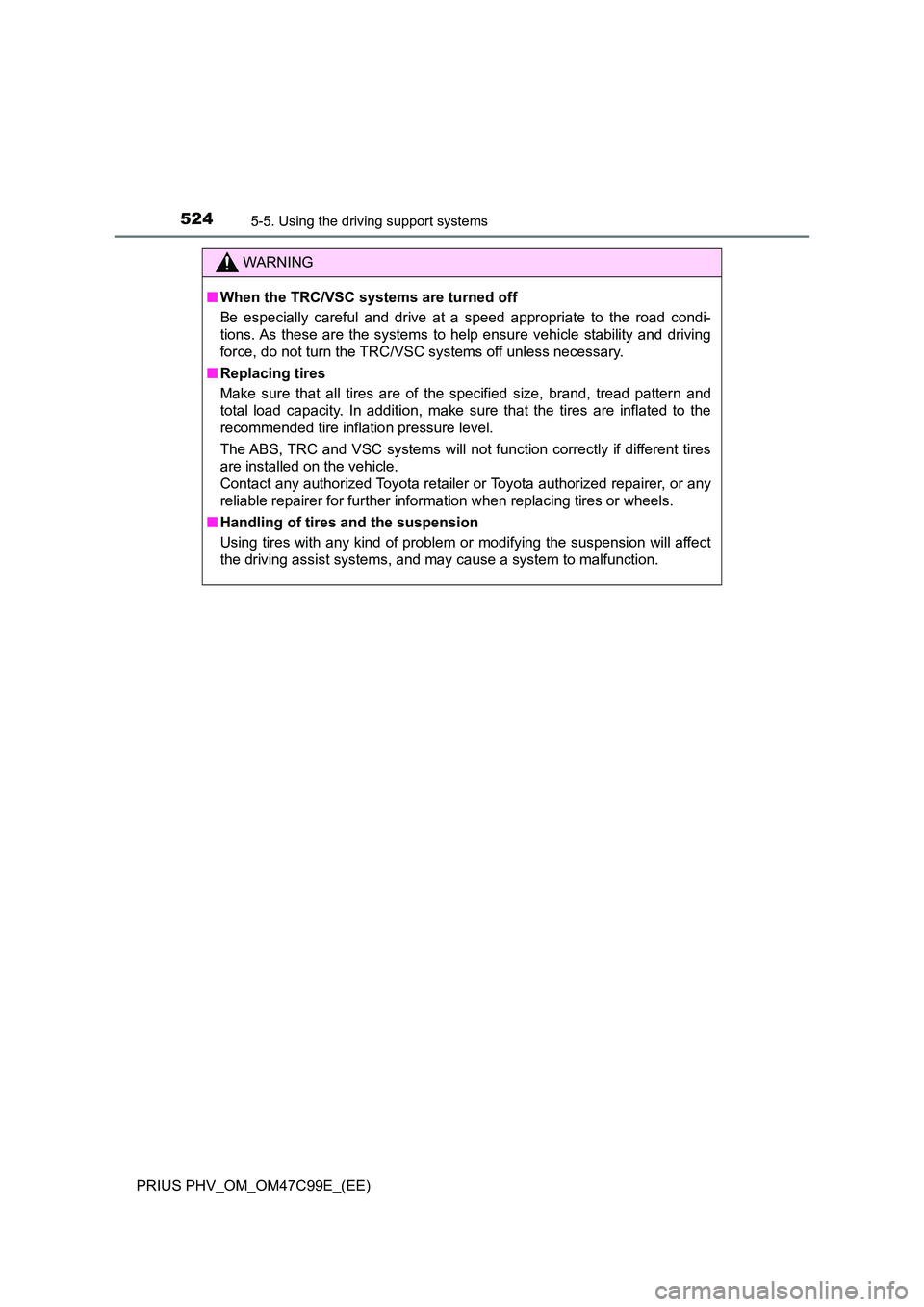
5245-5. Using the driving support systems
PRIUS PHV_OM_OM47C99E_(EE)
WARNING
■When the TRC/VSC systems are turned off
Be especially careful and drive at a speed appropriate to the road condi-
tions. As these are the systems to help ensure vehicle stability and driving
force, do not turn the TRC/VSC systems off unless necessary.
■ Replacing tires
Make sure that all tires are of the specified size, brand, tread pattern and
total load capacity. In addition, make sure that the tires are inflated to the
recommended tire inflation pressure level.
The ABS, TRC and VSC systems will not function correctly if different tires
are installed on the vehicle.
Contact any authorized Toyota retailer or Toyota authorized repairer, or any
reliable repairer for further information when replacing tires or wheels.
■ Handling of tires and the suspension
Using tires with any kind of problem or modifying the suspension will affect
the driving assist systems, and may cause a system to malfunction.
Page 571 of 772

571
7Maintenance and care
PRIUS PHV_OM_OM47C99E_(EE)7-1. Maintenance and care
Cleaning and protecting
the vehicle exterior .......... 572
Cleaning and protecting
the vehicle interior ........... 577
7-2. Maintenance
Maintenance
requirements.................... 583
7-3. Do-it-yourself maintenance
Do-it-yourself service
precautions ...................... 586
Hood .................................. 589
Positioning a floor jack ....... 591
Engine compartment.......... 592
Tires ................................... 606
Tire inflation pressure ........ 622
Wheels ............................... 624
Replacing the tire ............... 627
Air conditioning filter .......... 639
Wiper rubber
replacement ..................... 643
Electronic key battery ........ 646
Checking and replacing
fuses ................................ 649
Light bulbs ......................... 653
Page 586 of 772
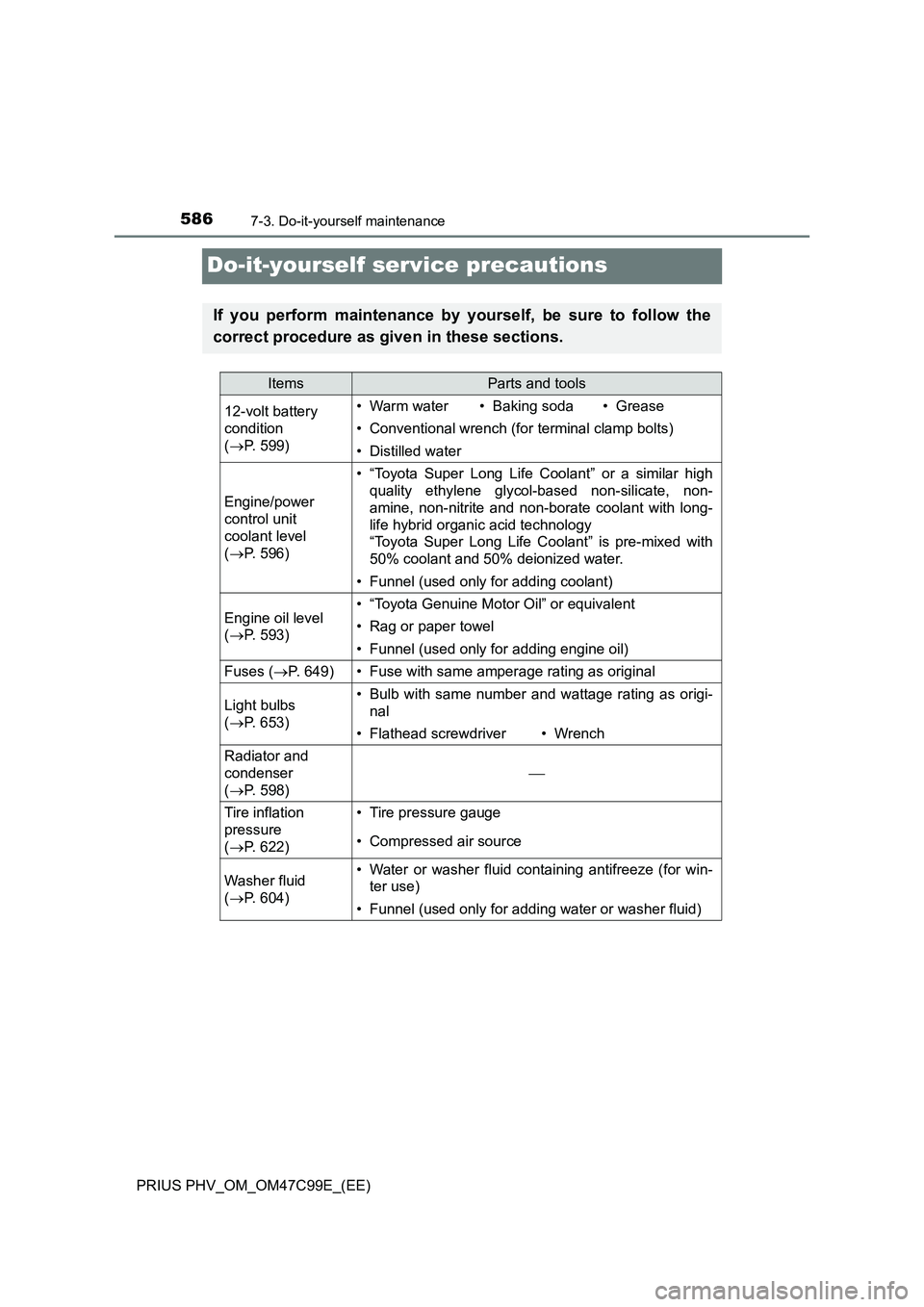
5867-3. Do-it-yourself maintenance
PRIUS PHV_OM_OM47C99E_(EE)
Do-it-yourself service precautions
If you perform maintenance by yourself, be sure to follow the
correct procedure as given in these sections.
ItemsParts and tools
12-volt battery
condition
(P. 599)• Warm water • Baking soda • Grease
• Conventional wrench (for terminal clamp bolts)
• Distilled water
Engine/power
control unit
coolant level
(P. 596)• “Toyota Super Long Life Coolant” or a similar high
quality ethylene glycol-based non-silicate, non-
amine, non-nitrite and non-borate coolant with long-
life hybrid organic acid technology
“Toyota Super Long Life Coolant” is pre-mixed with
50% coolant and 50% deionized water.
• Funnel (used only for adding coolant)
Engine oil level
(P. 593)• “Toyota Genuine Motor Oil” or equivalent
• Rag or paper towel
• Funnel (used only for adding engine oil)
Fuses (P. 6 4 9 )• Fuse with same amperage rating as original
Light bulbs
(P. 653)• Bulb with same number and wattage rating as origi-
nal
• Flathead screwdriver•Wrench
Radiator and
condenser
(P. 598)
Tire inflation
pressure
(P. 622)• Tire pressure gauge
• Compressed air source
Washer fluid
(P. 604)• Water or washer fluid containing antifreeze (for win-
ter use)
• Funnel (used only for adding water or washer fluid)
Page 607 of 772
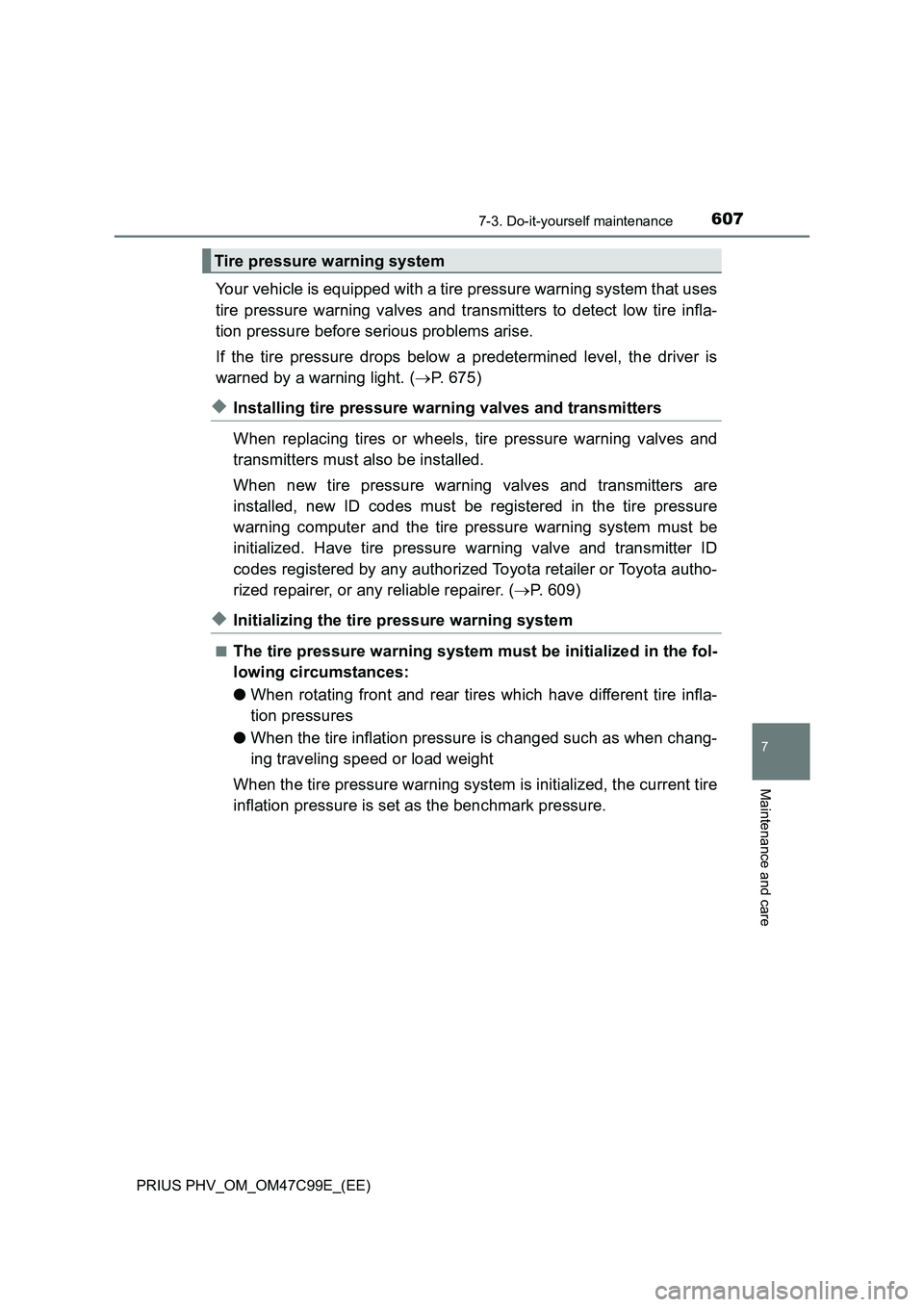
6077-3. Do-it-yourself maintenance
PRIUS PHV_OM_OM47C99E_(EE)
7
Maintenance and care
Your vehicle is equipped with a tire pressure warning system that uses
tire pressure warning valves and transmitters to detect low tire infla-
tion pressure before serious problems arise.
If the tire pressure drops below a predetermined level, the driver is
warned by a warning light. (P. 675)
◆Installing tire pressure warning valves and transmitters
When replacing tires or wheels, tire pressure warning valves and
transmitters must also be installed.
When new tire pressure warning valves and transmitters are
installed, new ID codes must be registered in the tire pressure
warning computer and the tire pressure warning system must be
initialized. Have tire pressure warning valve and transmitter ID
codes registered by any authorized Toyota retailer or Toyota autho-
rized repairer, or any reliable repairer. (P. 609)
◆Initializing the tire pressure warning system
■The tire pressure warning system must be initialized in the fol-
lowing circumstances:
●When rotating front and rear tires which have different tire infla-
tion pressures
●When the tire inflation pressure is changed such as when chang-
ing traveling speed or load weight
When the tire pressure warning system is initialized, the current tire
inflation pressure is set as the benchmark pressure.
Tire pressure warning system
Page 608 of 772
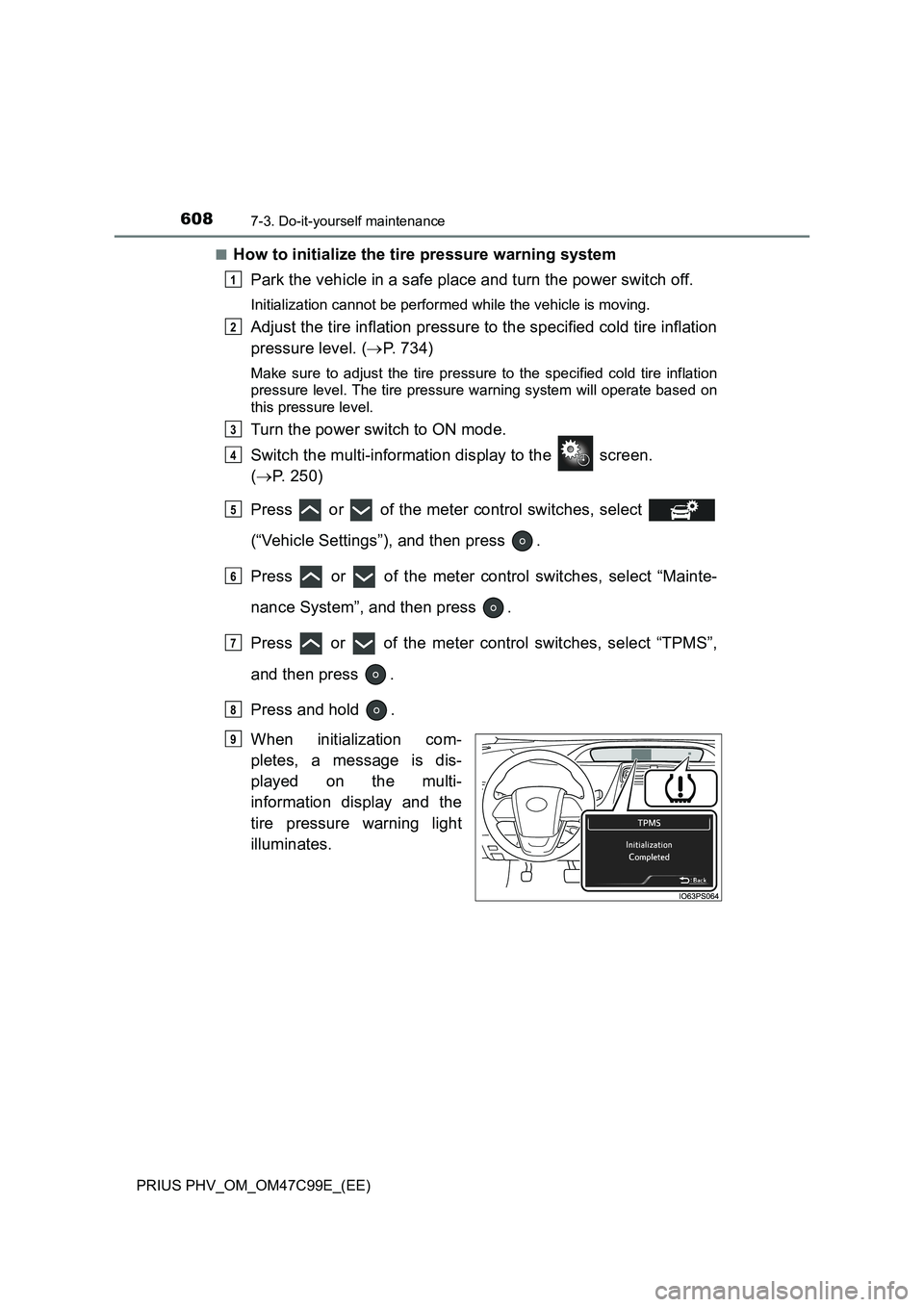
6087-3. Do-it-yourself maintenance
PRIUS PHV_OM_OM47C99E_(EE)■
How to initialize the tire pressure warning system
Park the vehicle in a safe place and turn the power switch off.
Initialization cannot be performed while the vehicle is moving.
Adjust the tire inflation pressure to the specified cold tire inflation
pressure level. (P. 734)
Make sure to adjust the tire pressure to the specified cold tire inflation
pressure level. The tire pressure warning system will operate based on
this pressure level.
Turn the power switch to ON mode.
Switch the multi-information display to the screen.
(P. 250)
Press or of the meter control switches, select
(“Vehicle Settings”), and then press .
Press or of the meter control switches, select “Mainte-
nance System”, and then press .
Press or of the meter control switches, select “TPMS”,
and then press .
Press and hold .
When initialization com-
pletes, a message is dis-
played on the multi-
information display and the
tire pressure warning light
illuminates.
1
2
3
4
5
6
7
8
Until Complete
9
Page 609 of 772
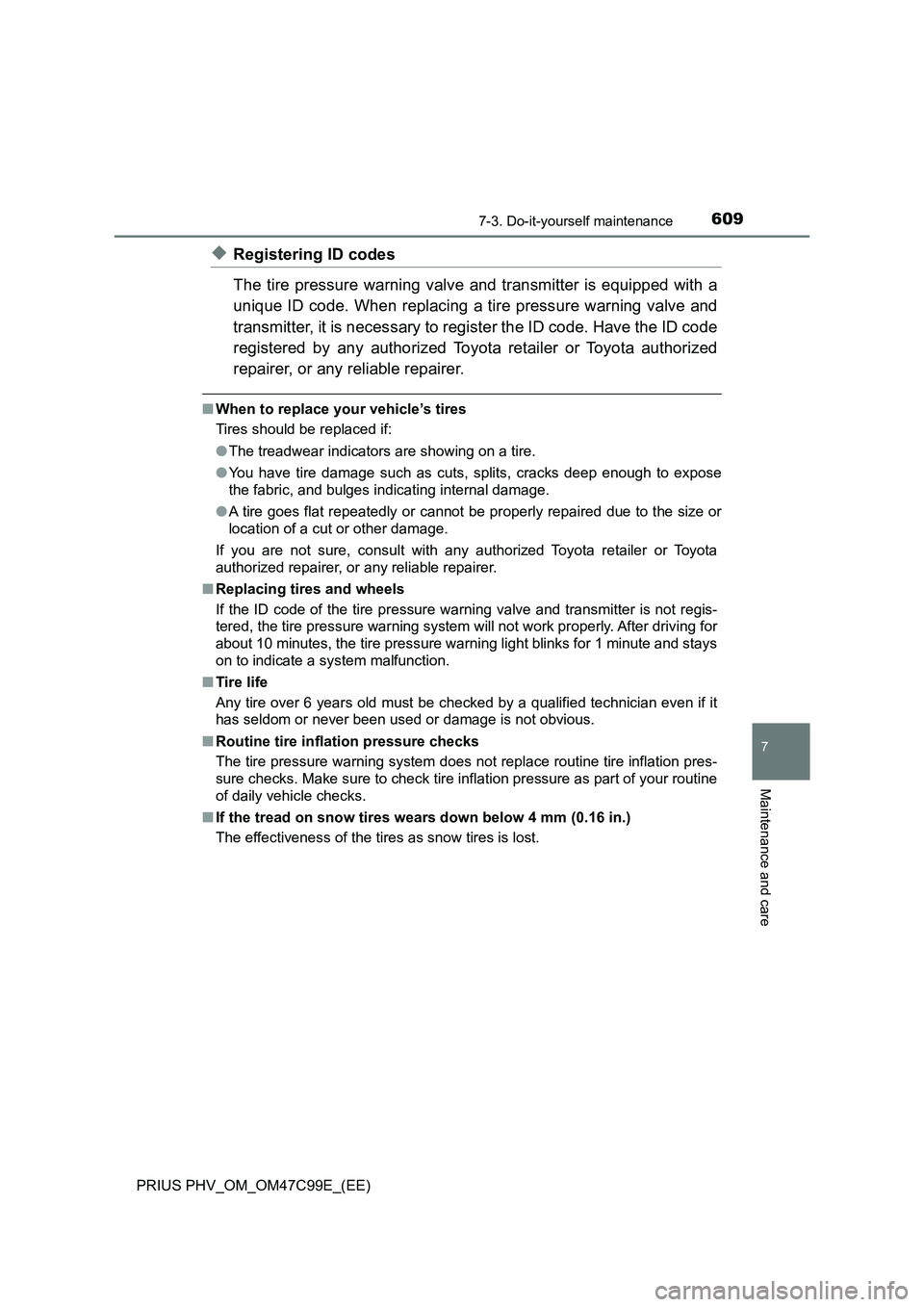
6097-3. Do-it-yourself maintenance
PRIUS PHV_OM_OM47C99E_(EE)
7
Maintenance and care
◆Registering ID codes
The tire pressure warning valve and transmitter is equipped with a
unique ID code. When replacing a tire pressure warning valve and
transmitter, it is necessary to register the ID code. Have the ID code
registered by any authorized Toyota retailer or Toyota authorized
repairer, or any reliable repairer.
■When to replace your vehicle’s tires
Tires should be replaced if:
●The treadwear indicators are showing on a tire.
●You have tire damage such as cuts, splits, cracks deep enough to expose
the fabric, and bulges indicating internal damage.
●A tire goes flat repeatedly or cannot be properly repaired due to the size or
location of a cut or other damage.
If you are not sure, consult with any authorized Toyota retailer or Toyota
authorized repairer, or any reliable repairer.
■Replacing tires and wheels
If the ID code of the tire pressure warning valve and transmitter is not regis-
tered, the tire pressure warning system will not work properly. After driving for
about 10 minutes, the tire pressure warning light blinks for 1 minute and stays
on to indicate a system malfunction.
■Tire life
Any tire over 6 years old must be checked by a qualified technician even if it
has seldom or never been used or damage is not obvious.
■Routine tire inflation pressure checks
The tire pressure warning system does not replace routine tire inflation pres-
sure checks. Make sure to check tire inflation pressure as part of your routine
of daily vehicle checks.
■If the tread on snow tires wears down below 4 mm (0.16 in.)
The effectiveness of the tires as snow tires is lost.